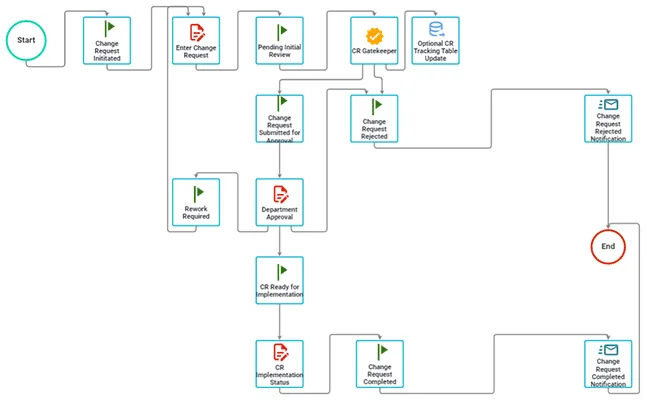Streamline Change Request Management with Automation
Table of contents

What is change control? Change control is a formal method for managing change requests to a project, product, or anything else that is subject to change.
Change control processes ensure projects stay on track and scope creep is held in check. Requests for changes can include software, employee status, and project plans. Regardless of the use case, change activities can be subject to confusion, faults, and disruption without a formal, reliable change control process. In addition, change management issues can multiply and wreak havoc on the process.
Change control process automation creates a consistent, systematic, and predictable way of managing change requests. By automating the change request process, the risk is reduced, and efficiency is greatly increased.
An automated change management system provides a comprehensive solution that oversees all tasks related to change management, such as impact assessments and approvals. By defining and automating the controls and policies involved in project changes, project team members have a reliable way of ensuring project scope is not compromised. Simply standardizing (and centralizing) the method for receiving, reviewing, and implementing change requests can positively impact project performance and outcomes.
So what is the benefit of change control to an organization? Ultimately, using a proper change control process will make projects more effective and efficient, helping them stay on time and under budget without additional scope creep ballooning costs.
What is Change Management?
Change management is a systematic approach to transitioning individuals, teams, and organizations from a current state to a desired future state. It involves managing and implementing changes to business processes, technology, and organizational structure to achieve strategic objectives. Effective change management ensures that changes are implemented smoothly, with minimal disruption to the organization, and that the benefits of the change are realized. By focusing on the human side of change, organizations can foster a culture of adaptability and resilience, ultimately driving long-term success.
Change Requests in Project Management
Change requests can often be seen as interruptions or impediments to projects but, in reality, they are a natural part of any project plan and drive innovation, error avoidance, and communication through the scope of the project.
However, the benefits of change requests are often mired in a tangle of poor process management including:
- Inconsistent information collection
- Lack of standardized routing and review
- Delays and long turnaround times
- Lack of transparency and accountability
- Poor reporting
Change Management Process
The change management process is a structured approach to managing changes within a project or organization. It involves a series of steps designed to ensure that changes are properly assessed, approved, and implemented. The typical steps in the change management process include:
- Record: Document the change request to ensure it is properly recorded and tracked.
- Assess: Evaluate the change request to determine its potential impact on the project or organization.
- Approve: Obtain necessary approvals for the change request, ensuring all stakeholders are informed and in agreement.
- Implement: Execute the change, ensuring it is properly tested and validated before full implementation.
- Review: Conduct a thorough review to confirm that the change has been successfully implemented and meets the required standards.
By following these steps, organizations can manage change requests effectively, minimizing disruptions and ensuring that changes contribute positively to the project’s success.
Automating Change Request Workflow
 Example of a custom change request form.
Example of a custom change request form.
Automating your change requests with workflow automation provides significant benefits like:
- Streamline and speed up change processes by reducing manual entry and request handling.
- Track change request status (completed, pending, or in progress, etc.) in real-time
- Identify performance trends (group and individual) over time.
- Reduced license overhead for enterprise systems (ERP, CRM, etc.)
- Reduce change errors and re-work.
- Reduce the risk of improperly approved change requests.
- Reduce the need for manual decision-making and handling business rules.
- Identify redundancies and improve change process efficiency.
- Improve compliance with audit trails.
- A unified, personalized change request experience for employees or clients.
- Monitor team progress against Service Level Agreements.
- Switch from single to parallel processing of change tasks.
- Eliminate circumvention of organizational business rules.
- Allow for 24/7 access to approve and monitor changes.
- Identify and remove process barriers or bottlenecks.
- Better align tasks with the skillsets and assign tasks to the most appropriate staff members.
Risk Assessment and Management
Risk assessment and management are critical components of the change management process. Changes can introduce new risks, making it essential to identify, assess, and mitigate them effectively. A comprehensive risk assessment involves identifying potential risks, evaluating their likelihood and impact, and developing strategies to mitigate them.
Risk management goes beyond assessment by implementing risk mitigation strategies and continuously monitoring their effectiveness. Regularly reviewing and updating the risk assessment and management plan ensures that it remains relevant and effective, adapting to new challenges and changes as they arise. This proactive approach helps in minimizing the negative impact of risks on the project and ensures smoother implementation of changes.
Continuous Improvement Through Analysis
By using an automation platform like Nutrient Workflow, not only will change request management become more efficient, but you will also have the opportunity to track and report on all aspects of the process. This intelligence feeds process improvement efforts, leading to a more streamlined, accurate process over time.
As bottlenecks and errors are discovered, tweaks can be made to the process, leading to more efficiencies. For instance, project managers may find that group approvals make more sense than individual approvals to ensure the approval process isn't held up when individuals are unavailable.
Benefits of Automated Change Requests
By using an automation platform like Nutrient Workflow for change requests and change orders, your department or business will realize meaningful gains.
- Reduced change cycle times.
- Fewer errors related to change requests.
- A clear, standardized process for all stakeholders.
- An improved work experience for both requesters and team members.
- Better transparency for executives.
Interested in Automating Your Change Request Process?
We have a variety of resources to help you on your journey to an automated workflow.
- Workflow Tools and eBooks
- Workflow Ideas Weekly eMail Newsletter(opens in a new tab)
- Recorded Demonstration of our Workflow Automation Software
- Request a Live Demonstration
FAQ
Change request management ensures changes in a project are handled efficiently, reducing disruptions and maintaining project goals.
Automation streamlines the process, reduces manual errors, and provides real-time tracking and transparency.
Challenges include inconsistent data collection, delays, lack of standardization, and poor reporting.
Yes, automation minimizes errors by using rule-based processing and standardized workflows.
Platforms like Nutrient Workflow provide comprehensive automation features to manage and optimize change requests.







